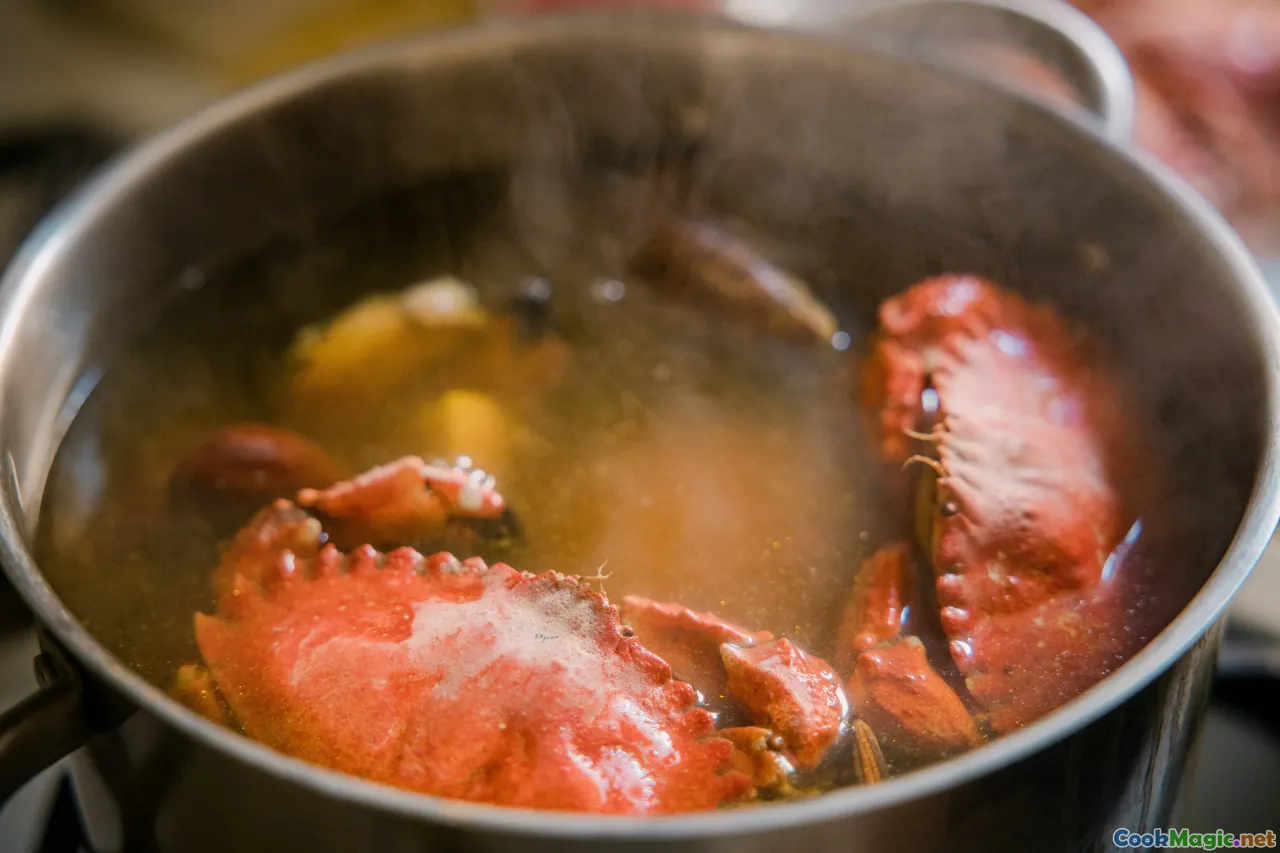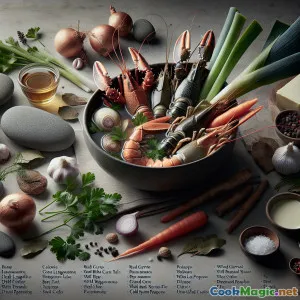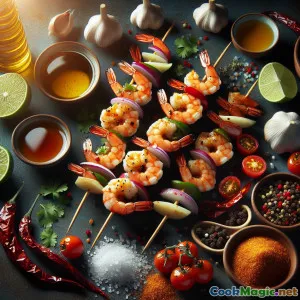
Pepperpot-Flusskrebs-Eintopf: Herzhaftes englisches Flussgericht
(Pepperpot River Crab Stew: Hearty English River Fare)
(0 Bewertungen)0
14
August 16, 2025
Problem melden
Zutaten
-
600 grams Frischer Flusskrebs
(Cleaned and cut into pieces, keep shell for flavor)
-
300 grams Yukon Gold Kartoffeln
(Geschält und gewürfelt)
-
1 medium Lauch
(Split lengthwise and washed, then sliced)
-
2 small Karotte
(Peeled and cut in small cubes)
-
2 stalks Selleriestange
(Sliced thin on the angle)
-
1 large Schalotte
(Dünn geschnitten)
-
1/2 medium Paprika
(Diced, use red or yellow for sweetness)
-
2 tbsp Worcestershiresauce
(Adds a tangy, umami punch)
-
3 tbsp Raffiniertes Rapsöl
(Zum Sautieren)
-
1 litre Krabbensud
(Prepared by boiling crab shells with aromatics)
-
1 tsp Getrockneter Thymian
(Or 2 tsp fresh thyme)
-
20 grams Frischer glatte Blattpetersilie
(Gehackt, plus extra zum Garnieren)
-
1.5 tsp Grobes Meersalz
(Nach Geschmack)
-
1 tsp Schwarzer Pfeffer
(Fresh ground)
-
1/2 tsp Pimentbeeren
(Zerdrückt)
-
1 small Scotch bonnet Chili
(Optional, zur Einstellung der Hitze)
-
100 ml Englisches Ale
(Optional, for depth and richness)
(Cleaned and cut into pieces, keep shell for flavor)
(Geschält und gewürfelt)
(Split lengthwise and washed, then sliced)
(Peeled and cut in small cubes)
(Sliced thin on the angle)
(Dünn geschnitten)
(Diced, use red or yellow for sweetness)
(Adds a tangy, umami punch)
(Zum Sautieren)
(Prepared by boiling crab shells with aromatics)
(Or 2 tsp fresh thyme)
(Gehackt, plus extra zum Garnieren)
(Nach Geschmack)
(Fresh ground)
(Zerdrückt)
(Optional, zur Einstellung der Hitze)
(Optional, for depth and richness)
Nährwerte
- Portionen: 4
- Portionsgröße: 1 bowl (about 350g)
- Calories: 402 kcal
- Carbohydrates: 37 g
- Protein: 22 g
- Fat: 16 g
- Fiber: 6 g
- Sugar: 7 g
- Sodium: 1380 mg
- Cholesterol: 117 mg
- Calcium: 102 mg
- Iron: 3.1 mg
Anweisungen
-
1 - Prepare Fresh Ingredients:
Clean and section the river crab. Dice potatoes, carrot, and bell pepper. Slice leeks, celery, and shallot. Mince chili if using. Chop parsley.
-
2 - Sauté Aromatics:
Heat rapeseed oil in a deep pot over medium heat. Add shallot, leeks, celery, and carrots. Sauté for 4 minutes until aromatic. Stir in bell pepper and continue for 2 minutes.
-
3 - Build the Stew Base:
Add potatoes to the pot. Scatter in thyme, allspice, black pepper, and sea salt. If using, add minced chili for extra heat.
-
4 - Deglaze and Simmer:
Deglaze vegetables with English ale, scraping up any browned bits (optional). Add Worcestershire sauce and crab stock. Bring to a gentle simmer.
-
5 - Cook Crab:
Nestle crab pieces (shell on) into the pot, ensuring they’re submerged. Gently simmer for 20-25 minutes, stirring occasionally, until crab is just cooked through and stew is fragrant.
-
6 - Finish & Garnish:
Stir through most of the chopped parsley. Taste and adjust seasoning. Serve in deep bowls, garnished with extra parsley and cracked pepper.
Clean and section the river crab. Dice potatoes, carrot, and bell pepper. Slice leeks, celery, and shallot. Mince chili if using. Chop parsley.
Heat rapeseed oil in a deep pot over medium heat. Add shallot, leeks, celery, and carrots. Sauté for 4 minutes until aromatic. Stir in bell pepper and continue for 2 minutes.
Add potatoes to the pot. Scatter in thyme, allspice, black pepper, and sea salt. If using, add minced chili for extra heat.
Deglaze vegetables with English ale, scraping up any browned bits (optional). Add Worcestershire sauce and crab stock. Bring to a gentle simmer.
Nestle crab pieces (shell on) into the pot, ensuring they’re submerged. Gently simmer for 20-25 minutes, stirring occasionally, until crab is just cooked through and stew is fragrant.
Stir through most of the chopped parsley. Taste and adjust seasoning. Serve in deep bowls, garnished with extra parsley and cracked pepper.
Mehr über: Pepperpot-Flusskrebs-Eintopf: Herzhaftes englisches Flussgericht
Pepperpot River Crab Stew: A Taste of Rural England with Island Influences
Pepperpot River Crab Stew is an inspired English dish that pays homage both to the bucolic riverbanks of the British Isles and the robust, spicy stews that have linked English kitchens with the Caribbean over centuries. While pepperpot is often associated with the Caribbean (and particularly Guyana), this English reinterpretation fuses centuries-old British seafood traditions with aromatic East Indian and colonial spice blends.
A Nod to Tradition & Reinvention
Crab has long been an emblem of English rivers and coasts, from Devon to Norfolk. Locals wading into shallow estuaries in early summer were a familiar sight, hauling baskets or string lines cradling fat brown river crabs, a mark of seasonal abundance. Traditionally these crustaceans found their way into simple, creamy bisques or cold salads; for this dish, robust spicing and hearty garden vegetables bring a wholly new aspect, integrating subtle ale-forward bitterness, sweet root highlights, and pepperpot allspice aromatics.
Unique Aspects
What sets this recipe apart is the careful mingling of English and Creole influences: Scotch bonnet chili and allspice reference the warmth and thrum of Caribbean kitchens, while leeks, shallots, rapeseed oil, and English ale ground the dish firmly in British culinary heritage. Retaining crab shells during simmering infuses the broth with rich marine undertones, and the final liberal garnish of flat-leaf parsley is quintessentially English—a familiar brightness to offset the depth of the stew.
Techniques & Tips
For best results, begin with the freshest river or estuary crab you can source. Clean thoroughly and handle the segments gently for maximum flavor extraction during simmering. Building flavor slowly by softening leeks, shallots, and carrots is key—don’t rush this part, as the oil carries their fragrance deeply into the stew. If you’re wary of extra spiciness, halve or even omit the chili; the pepperpot should evaporate softly, not overpower. English ale adds fudge-like undertones and subtle maltiness; choose a mellow, not bitter, ale.
Crab stock is simplest to make at home: reserve the crab shells, simmer for 40 minutes with aromatics (onion, parsley stems, celery trimmings), strain, and reduce slightly to amplify flavor. In a pinch, good seafood stock or even lightly salted water will suffice, but the dish will lose a degree of nuance.
Cultural Significance
Pepperpot River Crab Stew isn’t an entrée you'll find in an old English cookbook, but it speaks to England’s oft-overlooked culinary diversity — especially in modern times as British cooks draw inspiration, spices, and methods from global and empire connections. The inclusion of allspice (called Jamaica pepper in Victorian texts), once a rarity in London larders, speaks to centuries of global trade and the embrace of bolder, brighter seasoning in contemporary households.
Personal Notes
Serving this stew conjures warmth, riverside woods, rickety wooden tables, and lingering twilight. It’s a dish to eat communally, sleeves rolled up, fingers sticky from sweet crabmeat, bread at hand for swiping the peppery, savory juices. Pair with a fresh bitter-leaf salad and crumbly country bread for an evocative meal that honors the river’s generous harvest— but with a boldly spiced, cosmopolitan flavor echoing England’s role as both tradition bearer and cultural crossroads.
If you wish to be daring, experiment with other shellfish such as freshwater crayfish or add a splash of oat cream to lend mellow roundness to a natural stock. However you adapt it, Pepperpot River Crab Stew is a tribute to England’s riverside history, refreshingly vibrant, and exceedingly memorable on chilly nights.




















